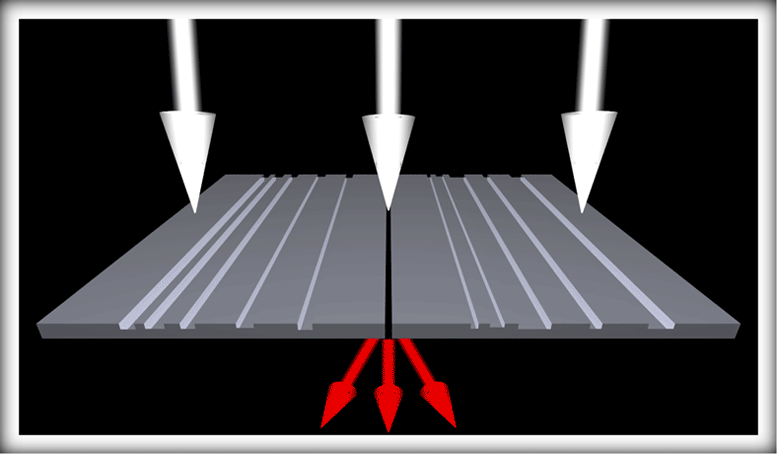_ بخش الکترونیک و نانو لیزر های صنعتی
بررسی و شناخت برهمکنش باریکۀ الکترومغناطیســی در" نانو لیزر های صنعتی "
پژوهشگر و نویسنده: دکتر ( افشین رشید)
نکته : برهمکنش باریکۀ الکترومغناطیســی به صورت بازتاب و شکست، جذب و پراکندگی رخ میدهد. بازتاب و شکســت توســط قوانین فرنل با هم ارتبــاط مییابند. لذا، این دو در یک بخش بیان میشــوند. البته در کاربرد های نانو لیزر، شکست فقط وقتی نقش مهمی ایفا میکند که ماده ای شفاف مانند مورد تابش واقع شود. این نکته که کدامیک از وقایع (بازتاب، جذب، پراکندگی) بیشتر باشد، به شرایط محل مورد تابش و طول موج باریکۀ ورودی بستگی دارد.
در رابطه برهمکنش باریکۀ الکترومغناطیســی نانو لیزر طول موج عامل بسیار مهمی است زیرا ضرایب شکست، جذب و پراکندگی وابسته به طول موج هستند. لذا، پرتوی نانو لیزری خواص جذب و پراکندگی بازتاب مورد نظر در عملکرد نانو لیزر ضروری است.بازتاب و شکست بازتاب عبارت است از برگشت باریکۀ الکترومغناطیسی توسط سطحی که پرتو به آن تابیده است. بازتاب بر دو نوع است: (بازتاب منظم و بازتاب غیرمنظم)هنگامیکه پرتوی ورودی از روی سطحی صاف و صیقلی با پستی بلندی هایی که در مقایســه با طول موج پرتوی فرودی کوچکتر است بازتاب میشود، آن را بازتاب منظم مینامند. بازتاب نامنظم پدیده ای است که به طورکلی برای تمام سطوح بهم ریخته و مات روی میدهد. زیرا هیچکدام از آنها دارای سطح صاف و صیقلی نیســتند ولی در مواردی خاص ممکن است بازتاب منظم بر نامنظم غالب باشد.
لیزر ها Laser پرتویی از تابش الکترومغناطیسی هستند. پرتوهای لیزر را می توان از نور مرئی ، اشعه ایکس ، اشعه ماورا بنفش یا نور مادون قرمز تهیه کرد.لیزر نوعی نور برانگیخته شــده و پرانرژی است که در شرایط عادی در طبیعت دیده نمیشود، ولی با فناوری و وسایل خاص میتوان آن را ایجاد کرد. لیزر با نور معمولی تفاوتهایی دارد که این ویژگیها باعث تواناییها و کاربردهای خاص آن میشود. نور لیزر درخشان تر و با شدت بیشتر از نور در طبیعت است. نور لیزر میتواند سخت ترین فلزات را بشکافد و به راحتی از جسم سختی مثل الماس عبور کند و در آن ایجاد حفره نماید. باریکه های کم قدرت و فوق العاده ظریف انواع دیگر لیزر را میتوان برای انجام کارهای بسیار ظریف مثل جراحی روی چشم انسان به کار برد. نور لیزر را میتوان با دقت بالایی تحت کنترل در آورد و به صورت باریکه ی مداومی به نام لیزر پیوسته یا انفجارهای سریعی به نام لیزر پالسی استفاده نمود. بر خالف نور معمولی نور لیزر دارای انرژی کاملًا هماهنگی است که به این واسطه قدرت زیادی برای انجام کارهای مختلف در آن ایجاد میشود. واژه ی لیزر از حروف اول کلماتی که توصیف کننده ویژگی های آن اســت به وجود آمده که به معنی تقویت نور توســط گســیل القایی تابش اســت.تفاوت پرتو لیزر با نور معمولی در خاصیت های مهمی است که در این پرتو وجود دارد. این خصوصیات عبارت اند از: همدوسی، تکفامی، مستقیم بودن شدت زیاد. خواص مذکور در نور معمولی دیده نمیشود و از این ویژگی ها برای کار های مختلف استفاده میشود.
نتیجه گیری :
برهمکنش باریکۀ الکترومغناطیســی به صورت بازتاب و شکست، جذب و پراکندگی رخ میدهد. بازتاب و شکســت توســط قوانین فرنل با هم ارتبــاط مییابند. لذا، این دو در یک بخش بیان میشــوند. البته در کاربرد های نانو لیزر، شکست فقط وقتی نقش مهمی ایفا میکند که ماده ای شفاف مانند بافت قرنیه مورد تابش واقع شود.
پژوهشگر و نویسنده: دکتر ( افشین رشید)
دکترایِ تخصصی نانو _ میکرو الکترونیک




